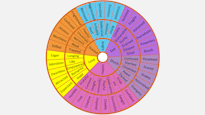Using the Emotion Wheel for Enhanced Self-Awareness in the Workplace
In today's fast-paced and interconnected workplace, emotional intelligence has emerged as a crucial skill set, influencing everything from collaboration and communication to decision-making and leadership.
Among the various tools available to enhance this critical skill, the Emotion Wheel stands out as a particularly effective instrument for fostering greater self-awareness and emotional clarity.
Originally developed to help individuals identify and articulate their feelings more precisely, the Emotion Wheel offers a unique framework that can be particularly transformative in a professional environment.
This article explores how leveraging the Emotion Wheel can lead to a deeper understanding of oneself and others, ultimately enhancing workplace dynamics and productivity.
By integrating this tool into daily work life, professionals of all levels can improve their interpersonal skills, manage stress more effectively, and create a more empathetic and supportive workplace culture.
Understanding the Emotion Wheel
The Emotion Wheel, also known as the Feeling Wheel, is a visual tool designed to aid individuals in identifying and understanding their emotions more clearly.
Its origins can be traced back to psychologist Robert Plutchik's theory of emotions in the 1980s, which proposed that emotions were not isolated experiences but interconnected and varied in intensity.
The wheel format, however, has been adapted and expanded upon by various psychologists and researchers over the years, each iteration aiming to offer a more nuanced exploration of human emotions.
How the Emotion Wheel Works
The Emotion Wheel operates on the principle that emotions can be categorized into a spectrum that reflects the complexity and depth of human feelings.
Typically, the wheel is divided into sections that start with core, or primary, emotions at the center and become more nuanced and specific as one moves outward.
By visualizing emotions in this manner, individuals can pinpoint their exact feelings with greater accuracy. The process involves identifying a primary emotion and then working through the wheel’s layers to discover a more precise descriptor of one's emotional state.
This practice not only aids in self-awareness but also in articulating these emotions to others.

Key Components of the Emotion Wheel Chart
-
Primary emotions: These are the wheel's core emotions and are universally recognized across cultures. They include basic feelings such as joy, sadness, fear, disgust, surprise, and anger. These emotions are instinctual and serve as the foundation for more complex feelings.
-
Secondary emotions: As one moves outward from the center of the wheel, the emotions become more specific. Secondary emotions are those that develop from the primary emotions and are influenced by individual experiences and perceptions. For example, 'joy' might expand into 'pride', 'optimism', or 'love'.
-
Tertiary emotions: These are even more refined emotions that branch out from the secondary ones, offering a detailed map of how basic feelings can evolve in response to different situations. For instance, under 'anger', one might find 'frustration', 'irritation', or 'rage'.
The Emotion Wheel serves as a dynamic tool for exploring the vast landscape of human emotions. By helping individuals dissect their feelings with greater precision, it promotes a deeper understanding of oneself and enhances emotional intelligence.
Whether in personal reflection or in communication with others, the Emotion Wheel facilitates a more empathetic and connected approach to discussing and managing emotions.
Using the Emotion Wheel Chart to Improve Self-Awareness
Emotional self-awareness – the ability to understand and recognize one's own emotions and their impact on behavior and thought – plays a pivotal role in the professional environment.
Its significance touches various aspects of the workplace, from individual job performance to collective dynamics and leadership effectiveness.
Emotional self-awareness is a foundational element of emotional intelligence, which is directly correlated with job performance.
Individuals who possess a high degree of emotional self-awareness can:
- Better manage their stress levels
- Navigate challenges
- Adapt to changes
- Recognize their strengths and limitations
- Achieve more harmonious and efficient collaborations
- Encourage a culture of inclusivity and respect
- Be better managers
- Motivate and inspire their employees
The Emotion Color Wheel is a practical tool for enhancing emotional self-awareness in the workplace. Its application can lead to improved communication, decision-making, and relationships among colleagues.
Here's how you can use the Emotion Color Wheel in everyday work scenarios, along with examples and tips for making it a regular part of your work routine.
- Identify your initial feeling: Start by acknowledging the first emotion that comes to mind. This could be a primary emotion located at the center of the Emotion Wheel.
- Refine your emotion: Look at the surrounding emotions on the wheel that stem from your initial feeling. Are there more specific emotions that describe your state more accurately?
- Consider the cause: Once you've pinpointed a more precise emotion, think about what triggered this feeling. Understanding the cause can help in addressing the underlying issues.
- Reflect on the impact: Think about how this emotion influences your behavior, decisions, and interactions at work. Is it affecting your productivity or relationships with colleagues?
- Develop a response plan: Decide on the best way to address or communicate your feelings. This might involve problem-solving, seeking support, or expressing your emotions constructively to others.
Examples of Recognizing Complex Emotions Through the Emotion Wheel
The Emotion Wheel is a powerful tool for dissecting complex emotions and facilitating effective responses to workplace challenges.
By providing a nuanced understanding of one’s feelings, it can guide actions that enhance personal wellbeing and professional relationships.
Below are detailed examples of how the Emotion Wheel can be used to address specific emotional situations at work.
In both scenarios, the Emotion Wheel serves not only to identify and articulate complex emotions but also to guide constructive action.
By using this tool, individuals can navigate their emotional landscapes with greater precision and develop strategies to address the root causes of their feelings, leading to more positive outcomes in the workplace.
Scenario 1: Addressing Feelings of Being Undervalued
Initial Feeling: Upset after a team meeting.
Using the Emotion Wheel:
You start with the primary emotion of sadness or anger you feel immediately after the meeting. Moving outward on the Emotion Wheel, you identify that your precise feeling is frustration, which is more specific than just being upset.
This frustration is recognized to stem from feeling undervalued when your contributions were not acknowledged during the meeting.
Action Steps:
Reflect on specific instances during the meeting that led to these feelings. This could involve moments when your ideas were overlooked or when credit was given disproportionately.
Schedule a one-on-one meeting with your manager. Prepare by listing your recent contributions and the outcomes they have achieved for the team or project.
Express your feelings using "I" statements to communicate your emotions without placing blame, such as, "I felt overlooked during the meeting when X was discussed, and I believe my contributions in Y area could bring additional value."
Seek constructive feedback on how to enhance your visibility and recognition within the team.
Scenario 2: Navigating Anxiety and Uncertainty About a New Project
Initial Feeling: Nervousness about leading a new project.
Using the Emotion Wheel:
Identify nervousness as a primary emotion, likely stemming from fear.
Further exploration on the Emotion Sensation Wheel helps you pinpoint that the specific emotions are a mix of anticipation and anxiety.
This nuanced understanding reveals that your anxiety is due to the uncertainty surrounding the project's direction and your role in its success.
Action Steps:
Acknowledge these feelings and consider what information or resources would mitigate your uncertainty.
Initiate a planning session with your team or project stakeholders. Aim to define clear objectives, milestones, and everyone's roles and responsibilities.
Express your feelings and concerns in the meeting, focusing on the need for clarity to ensure the project's success. For example, "To move forward confidently, I believe it's crucial that we clarify our project goals and how we plan to achieve them."
Ask for regular check-ins with your team and stakeholders to adjust plans as needed and to ensure that concerns are addressed promptly.

How to Integrate the Emotion Wheel Chart Into Work Routines
By thoughtfully integrating the Emotion Sensation Wheel into your daily and collective work practices, you and your team can embark on a journey toward greater emotional clarity, improved interpersonal interactions, and a richer professional life.
Step 1. Establish a Daily Emotion Check-in Ritual
Allocating a few quiet minutes either at the beginning or end of your workday for an emotional check-in can significantly enhance your self-awareness.
Use the Emotion Wheel to pinpoint and reflect on your feelings, noting any patterns or triggers over time. This routine not only fosters a deeper understanding of your emotional landscape but also helps in managing stress and maintaining a balanced perspective.
Step 2. Integrate Emotion Discussions in Meetings
Make the Emotion Wheel a staple in team discussions, especially during meetings that involve project planning, retrospectives, or any decision-making processes.
This practice encourages team members to articulate their feelings regarding work matters openly, paving the way for enhanced empathy, better conflict resolution, and a more cohesive team dynamic.
It’s an effective strategy for acknowledging and valuing each member's emotional investment in their work.
Step 3. Promote an Emotionally Intelligent Culture
Share the utility and benefits of the Emotion Wheel with your peers and leadership, advocating for its adoption as a common vernacular for emotional expression within your organization.
This initiative can play a pivotal role in nurturing a supportive and inclusive workplace culture, where emotional intelligence is recognized as an asset.
Organize workshops or informal sessions to demonstrate its application, highlighting how it can lead to healthier work relationships and a more vibrant office atmosphere.
Step 4. Embed Emotion Analysis in Personal and Team Growth Plans
Incorporate the Emotion Wheel into personal development discussions and team growth strategies as a tool for identifying areas for emotional and interpersonal skill enhancement.
Use it to set specific, actionable goals related to emotional intelligence, such as improving empathy, resilience, or communication.
This approach ensures that emotional growth is given priority alongside professional development, contributing to well-rounded career progression.
Step 5. Regular Reflection and Adaptation
Make a habit of periodically reviewing how effectively the Emotion Wheel is being incorporated into your and your team's routines.
Solicit feedback on its impact and look for opportunities to adjust your approach for broader acceptance or deeper integration.
This reflection can lead to continuous improvement in how emotions are managed and expressed at work, fostering a more emotionally aware and responsive work environment.
The Emotion Wheel is a visual tool designed to help individuals identify and understand their emotions more accurately.
It categorizes feelings from basic to complex, enabling users to articulate their emotional state with precision, fostering improved self-awareness and communication.
By facilitating a deeper understanding and articulation of emotions, the Emotion Wheel can enhance empathy, reduce conflicts, and improve communication among colleagues.
It promotes a culture of openness, where emotional insights lead to more supportive and effective teamwork.
Yes, the Emotion Wheel can be integral to professional development by highlighting emotional intelligence as a key area for growth.
It aids in setting personal goals related to emotional awareness and regulation, which are crucial skills for leadership, collaboration, and adapting to workplace challenges.
Absolutely. The Emotion Wheel is versatile and can be beneficial in any work setting. Its use fosters an emotionally intelligent culture, conducive to productivity and job satisfaction, regardless of the industry or organizational structure.
Regular use is recommended. Consider a daily check-in with yourself or integrating it into team meetings as appropriate.
The frequency can be adjusted based on individual or team needs, but consistency is key to reaping its benefits for emotional growth and communication.
Final Thoughts
The Emotion Wheel stands as a transformative tool in the landscape of professional development and workplace dynamics.
Its application transcends mere emotional identification, venturing into the realms of enhanced self-awareness, improved interpersonal relationships, and the cultivation of an emotionally intelligent culture.
By integrating the Emotion Wheel into daily routines and organizational practices, individuals and teams can navigate the complexities of workplace emotions with grace, leading to more effective communication, increased empathy, and a more supportive and productive work environment.
The journey towards emotional clarity and understanding, facilitated by the Emotion Wheel, not only enriches professional experiences but also contributes to personal growth and wellbeing. Embracing this tool is a step forward in fostering a workplace that values and thrives on emotional intelligence.




